#Indo European
Text
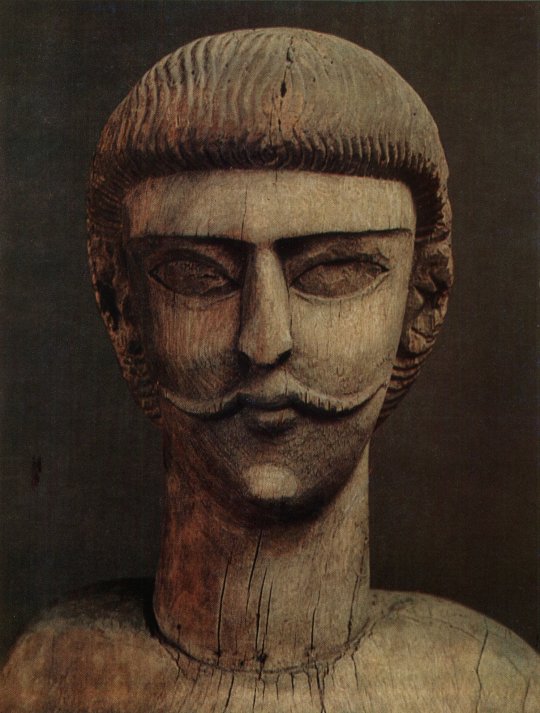


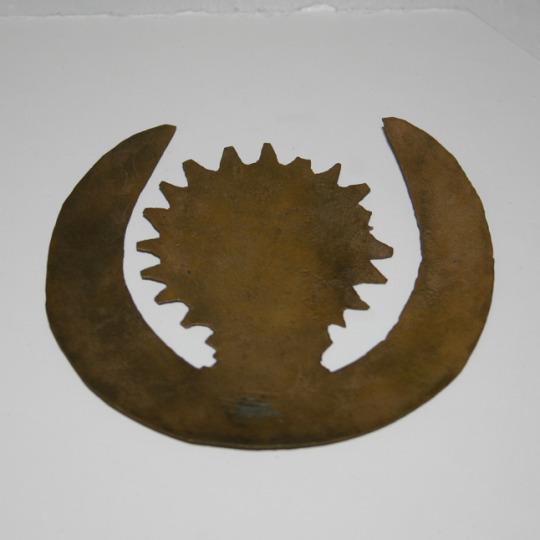
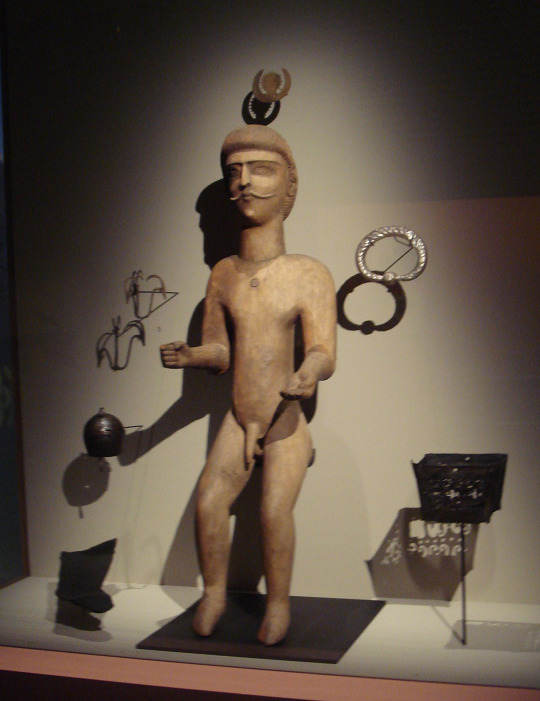


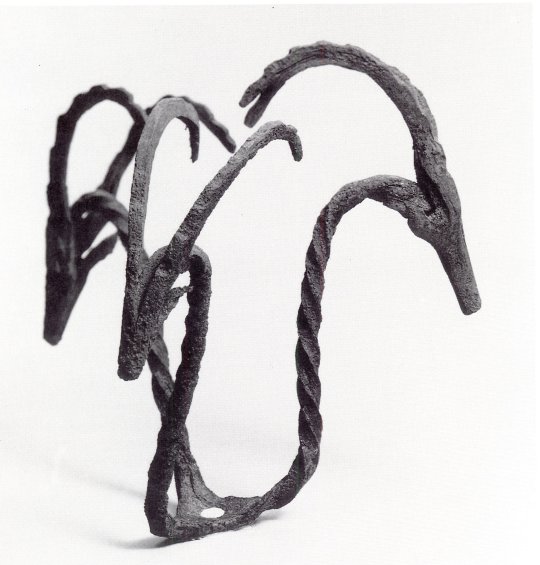
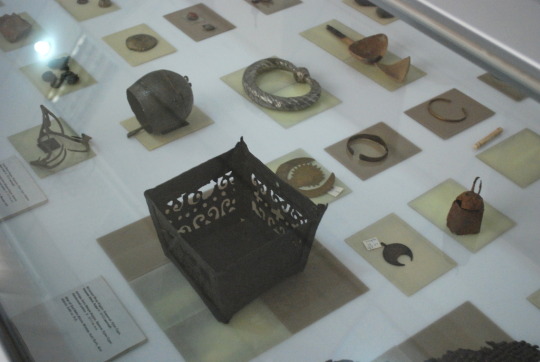
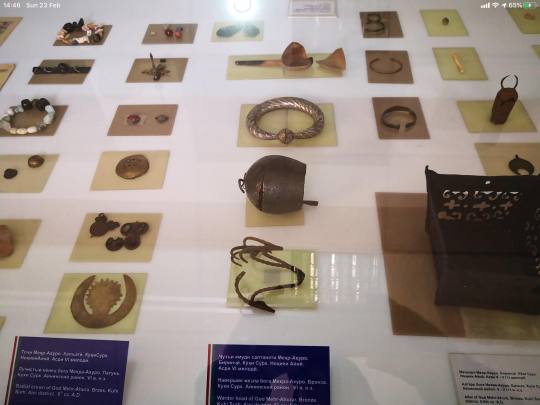
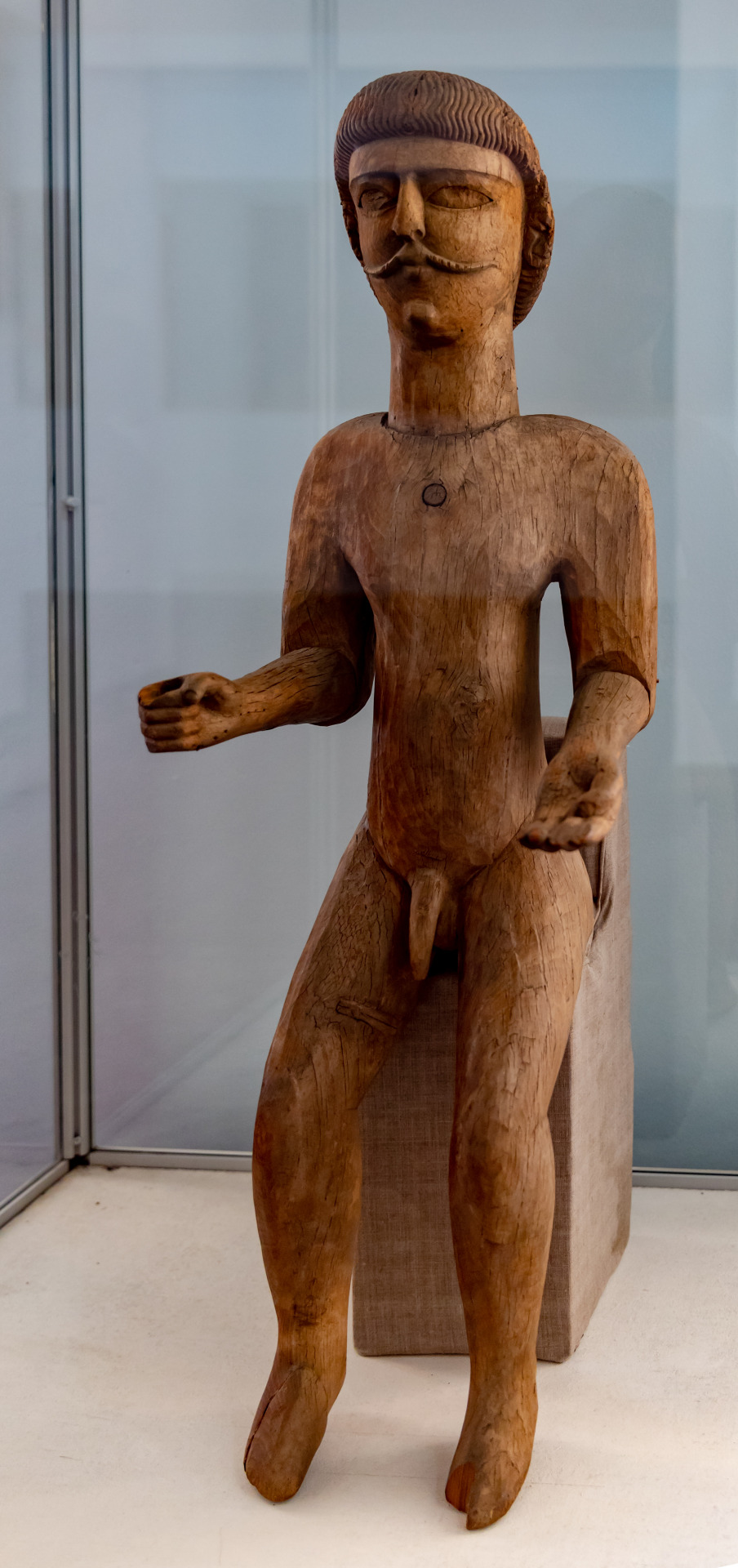
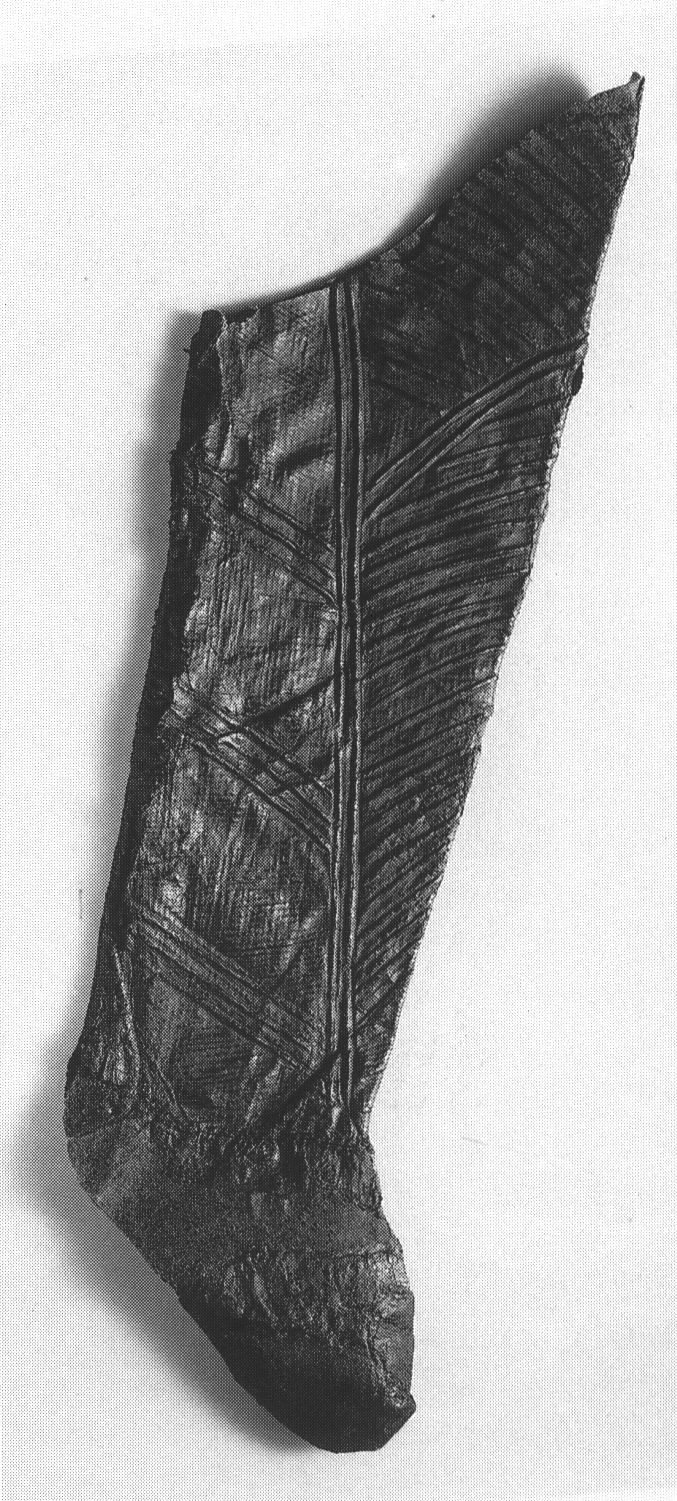
Sogdian wooden idol from Kuh-i-Surkh (Tajikistan) 5th-8th C. CE
"Head of a Sogdian carved wooden idol, found in a cave at Kuh-i-Surkh, Tajikistan. The idol was originally adorned with clothing, jewelry, a diadem, a sceptre, and an incense burner, and must have been hidden in a cave after the Arab conquest. In its heyday, the idol would have worn a crown, a long robe, boots, and carried a sceptre and a censer. At his feet were gifts donated by worshippers - swords, daggers, jewellery, armour, among other things."
-taken from Nadeem - Eran ud Turan's twitter
#sogdiana#ancient history#history#antiquities#art#sculpture#statue#museums#pagan#paganism#woodworking#woodcarving#asian art#indo european
245 notes
·
View notes
Text
Indo-Europeans be like what do you mean you can't conjugate this verb? It's a regular i-stem verb of the ua subclass of the eu sub-sub class of the ye sub-sub-subclass that nazalizes, palatalizes, and undergoes anywhere from 17 to 30 different forms of umlaut simultaneously depending on what conjugation you're using and gets replaced with a completely different verb when it's passivized!
#linguistics#linguistic#languages#shitpost#linguist shitpost#lingblr#indo european#indo european languages
337 notes
·
View notes
Text
“The popular concept of the primitive family group, complete with domineering father, cowed and submissive mother, and tumbling human cubs littering the cave-home floor, has been completely discredited; yet it remains the image of ‘caveman’ life as portrayed in the widely disseminated media of comic strip and television serial today.
The fact is that the earliest human family consisted of a woman and her children. ‘The patriarchal family was entirely unknown,’ writes Lewis Henry Morgan. ‘It was not until after recorded civilization commenced that it became established.’ Fatherhood and the idea of permanent mating were very late comers in human history. So late, as a matter of fact, is the idea of paternity that the word for father does not even exist in the original Indo-European language, as the philologist Roland Kent points out.
The Encyclopaedia Britannica (1964 edition) says that where no word existed in the ancient Indo-European language for any concept or object, it may be accepted as a truism that that concept or object was unknown to the Indo-Europeans. And since this original language did not break up into the classical and modern languages that have descended from it, according to Kent, until about 3000 B.C., it seems obvious that fatherhood was unknown even as recently as five thousand years ago.”
-Elizabeth Gould Davis, The First Sex
764 notes
·
View notes
Text
Review of The Horse, the Wheel, and Language: How Bronze-Age Riders from the Eurasian Steppes Shaped the Modern World by David W. Anthony

I will be upfront, it is a very technical book. If you are not well versed in the anthropological categorizing of cultures and time periods of the areas being discussed it can be very difficult to keep up with the more finite points the author is making. That being said, I had never heard of any of the specific cultures being discussed in the Danube Valley and was still able to enjoy this book and its well put together analysis of various aspects of language, culture, technological developments and shifts in behaviors and place.
If you are especially interested in any of the major themes this book discusses (which is in all honesty is an extensive list including but not limited to; the development of Indo-European language, the time periods and locations as well as likely motivation for domestication of various livestock types, the cultural effects of technological developments on the peoples of the Eurasian Steppes and their migration/trading patterns) I do highly recommend. It is heavy reading but extremely illuminating.
#The horse the wheel and language#David W Anthony#historical anthropology#anthropologist#anthropology#ancient languages#language#historical linguistics#linguistics#proto indo european#indo european#steppes#eurasian#eurasian steppe#horse#horses#husbandry#burials#Cattle#sheep#book review
158 notes
·
View notes
Text
friends I found a link where you can learn to read ancient languages (for free)
107 notes
·
View notes
Text
We tend to think languages of different groups within the same family are so much more difficult to learn than languages of the same group until we try to learn a language that is actually from a different family
Sure, as a Portuguese speaker, it's harder to learn English than to learn Spanish, but it doesn't compare to trying to learn Inuktitut or Japanese, than you find out English and Spanish are actually more of less at the same level of difficulty
When you start studying Chinese or Tupi you think "dang, it's not enough to replace a word for another and change word order, I have to think about the world around me in a completely different way, I have to relearn from scratch what it means to speak a language"
#languages#lingblr#langblr#language learning#language families#language groups#indo european#english#portuguese#spanish#inuktitut#japanese#tupi#tupi guarani#chinese
85 notes
·
View notes
Text
A look at the etymology of the "arithmonyms" from the Locked Tomb series by Tamsyn Muir, arranged by difficulty level.
Easy:
-Deuteros = Ancient Greek δεύτερος (deúteros) "second"
-Dve = Pan-Slavic две/dvě "two"
-Tettares = Ancient Greek (Attic) τέττᾰρες (téttares) "four"
-Chatur = Sanskrit चतुर् (catur) "four"
-Pent = Ancient Greek πέντε (pénte) "five"
-Quinque = Latin quīnque "five"
-Sextus = Latin sextus "sixth"
-Hect = Ancient Greek ἕκτος (héktos) "sixth"
-Sex = Latin sex "six"
-Septimus = Latin septimus "seventh"
-Asht = Sanskrit अष्ट (aṣṭa) "eight"
-Oct = Latin octō "eight" or Ancient greek ὀκτώ (oktṓ) "eight"
-Nav = Sanskrit नव (nava) "nine"
Intermediate:
-Dyas = Ancient Greek (late medieval pronunciation) δῠᾰ́ς (duás) "the number two, couple, pair, diad"
-Tern = Latin ternī "three each, three at a time"
-Trinit = Latin trīnitās "the number three, triad, trinity"
-Tetra = Ancient Greek τετρᾰ́ς (tetrás) "the number four, the fourth day", or τετρα- (tetra-), prefixed form of τέττᾰρες (téttares) "four"
-Quinn = Latin quīnī "five each, five at a time", or quīn-, prefixed form of quīnque "five"
-Shodash = Sanskrit षोडश (ṣoḍaśa) "sixteen"
-Ebdoma = Ancient Greek (Koine pronunciation) ἑβδομάς (hebdomás) "a group of seven"
-Nonagesimus = Latin nōnāgēsimus "ninetieth"
-Novenarius = Latin novēnārius "containing or consisting of nine things"
-Novenary = Latin novēnārius (see above)
Advanced:
-Tridentarius = Neo-Latin tridēntārius "like a trident", from Latin tridēns "three teeth"
-Zeta = Sixth letter of the Greek Alphabet (although in Ancient Greek numerals it actually represents the number 7, because the original sixth letter was the now disused digamma)
-Heptane = Neo-Greek-Latin compound heptane, "saturated aliphatic hydrocarbon C7H16" (more literally "pertaining to the number seven, seven-like")
-Nonius = Latin Nōnius, a first name derived from the Nōnia plebeian family, ultimately from nōnus "ninth"
-Nova = Latin novem "nine" and/or nova "new" (it's been suggested that the Proto-Indo-European root *h₁néwn̥ "nine" is derived from the root *néwos "new")
Expert:
-Octakiseron = Ancient Greek ὀκτᾰ́κῐς (oktákis) "eight times" + unclear suffix, could have been constructed by analogy with -τερον (-teron, as in δεύτερον (deúteron) "second") and -μερον (-meron, as in ἑξαήμερον (hexaḗmeron) "six days"); alternatively based on or reinforced by the French diminutive suffix -eron, an extension of the diminutive -on (itself a merger of several Latin and Frankish suffixes), built by analogy with words like quarteron "quadroon" (from quartier "quarter, district" + -on); yet another possibility is Ancient Greek εἴρων (eírōn) "one who says less than they think, dissembler, pretender"
-Noniusvianus = not clear, perhaps a portmenteau of Latin Nōnius (see above) and noviēs "nine times", with an adjectival ending -(i)ānus.
-Nigenad = perhaps based on Proto-West Germanic *nigundō "ninth" (variant of the more common *neundō), or one of its descendants (Dutch negende, Middle English nyghend, West Frisian njoggende…); possibly reinforced by Old English nigonfeald "ninefold"
#the locked tomb#gideon the ninth#harrow the ninth#nona the ninth#arithmonym#etymology#tamsyn muir#linguistics#latin#greek#sanskrit#numbers#germanic#indo european#slavic#worldbuilding
231 notes
·
View notes
Text
Roman Gods ≠ Greek Gods

Okay, given that Stray Gods has kinda pulled me into that Mythology thing again... Let me quickly say something: No, the Roman Gods are not just the Greek Gods.
A lot of media - like A LOT - acts as if the Roman Gods are just basically the Greek Gods with some minor changes. But, like... They are not. And acting as if they were is simply misunderstanding how religions and thier mythologies work.
If you were to look at it like this, you could argue that YHW is Zeus and is Susanoo as well, if we are on that. (Alright, last one is a topic we gotta argue about.) Because here is the thing: All European and a good chunk of Asian and some North African cultures came from or were influenced by the Indo-Europeans. Aka, some folks who lived some more than 6000 years ago, who were a big influence in making horses a thing and promptly used those horses to spread over the previously mentioned areas. With them they brought their languages and their mythology. Both things that shifted over hundreds of years, creating on one hand the different languages - as well as the different mythologies.
Greek, Roman, Egyptian and Norse mythologies are part of that. As is the Semitic mythology - which obviously birthed Judaism, Christianity and Islam.
The gods did not originate with the Greeks. They were much older than that. We even know from where some of the Greek gods came, as we have fragments documenting them being worshiped by some pre-greek cultures.
Which is kinda where the entire thing with the Greeks and Romans comes in. The incorporation of the Greek gods to the Roman religion seems so obvious to us, because it is so well documented. Because both cultures wrote down a lot of stuff, which gave historians the amazing ability to understand a lot more about their culture and religion - because they could read all of it. It is not like with the Norse or the Celtic mythology where the people in question only transmitted those stories orally, making it so that the first to write those stories down were people who did not actually believe in them/practiced the religion and wrote them down from a more or less outsiders perspective. So, we know a lot of those gods and we can very clearly see that the Romans adapted a lot from the Greeks.
But... here is the thing: Not only they adapted them, but quite a few gods were also fused with deities local to Rome and what is modern day Italy. Both things were merged - and there are in fact some gods in which the Italic version of them is more influencial than the Greek one.
Obviously, the Italic people were also from Indo-European roots, so yeah, it probably made sense to merge Zeus and Diespiter, who both were "sky fathers" into one deity.
Yes, there was a whole political aspect in taking over the pantheon.
But saying "Oh, yeah, they just painted over the names" is just ignorant of the cultural context.
#rant post#greek mythology#roman mythology#ancient greece#ancient rome#indo european#history#ancient history#mythology#hades#stray gods#rick riordan
122 notes
·
View notes
Text

16th of October
Navratri Day 2
#kollywood#jodhadreams#jodha dreams#bollywood#tamil#tollywood#south indian#sareestyle#sareeblogger#indianwoman#sareelook#saree aesthetic#sareenotsorry#indo european#south asain#retro aesthetic#retro indian#retro look#navratri#hindufestival#hindu woman#sareedraping
49 notes
·
View notes
Text
what i believe different romance languages taste like
Spanish: Mango Ice Cream.
idk, the vowels and the way you pronounce stuff is very upbeat and smiley and stuff, plus most spanish speakers talk super duper fast and im holding on for dear life trying to listen and silmontaniuosly translate in my head. plus spain is warm.

French: Strepsils
specifically lemon ones, i only did french for a year in school and hated it. dont get me wrong the language is pretty but you have to like pronounce stuff out of your nose and all(?), so the weird feeling and aftertaste in your mouth after a throat sweet is just fitting

Portuguese: Watermelon
its fitting. sometimes watermelon's sweet and juicy other times its anemic and really watery. just like how portuguese sounds super cool put people water it down as just another version of spanish. Plus it's such a summery language if that makes sense, like it just sounds bright but it feels earthy, so maybe a watermelon with dirt on it or smthn, idk it sounds a lil crunchy but still bright yk

Italian: Winegums
Italian's got this sophisticated edge to it, especially with the music + art history in Italy. It feels like the head of the (i think its called 'the romance language) family. Wine gums are good, they're still kinda sweet and fun to suck on when you've got fuck all else to do or your ears have popped cus you're in an aeroplane, but they still taste mature if that makes sense. it's not a go to, but it's a staple, and your granny probably has it in her handbag or in her car as a travel sweet.

Romanian: Werthers Original Butter Candies
they're sweet and smooth and kinda melt on your tongue, which is what Romanian sounds like to me yk. but they also feel mature and it's got this kinda feel to it that Spanish or Catalan doesnt have where it's slightly sharper in the way you pronounce words and stuff, but still soft enough. Romanians a unique language, (all languages are unique but oh well), its not sought out by learners like Spanish or French but its still a staple, which is why werthers fits.

Catalan: Passion Fruit Margarita
i'm not explaining myself on this one.

i might continue this with other indo-european languages, though idk if i want to do baltic, slavic, germanic or celtic next🧍
#ailillgachuair#languages#spanish#french#catalan#italian#portuguese#spain#portugal#italy#france#romance languages#romantic languages#indo european#indo european languages#linguistics#language
58 notes
·
View notes
Note
Could you talk about Gaelic? How many people are speak it today?
Indeed I can!
SCOTTISH GAELIC
"Gaelic" as a term can refer to any of the Goidelic branch of languages, which includes Irish, Scottish Gaelic, and Manx. HOWEVER, since today (November 30th) is Saint Andrew's Day, Scotland's national day, let's talk about Gàidhlig na h-Alba, or Scottish Gaelic! Latha Naomh Anndra sona dhuibh!
When referring to Scottish Gaelic, we pronounce the word "Gaelic" not as "gey-lick" but as "gal-lick", owing to its native pronunciation (which you can listen to here).
BEFORE THIS POST GETS TOO LONG, I urge the reader to consider learning this language! It's the source of my name after all ("Ian" is a form of "Iain" or "Eòin", both Gaelic forms of "John") and is the heritage language of as many as 40 million people worldwide. Even if you don't claim any Scottish ancestry, it's a beautiful and poetic language tied to an equally beautiful and poetic culture! Use it as a code language with your friends, read some classic Gaelic literature, or even pay a visit to Scotland and smugly read Gaelic road signs off to your friends/family/tour guide! (They'll love it, I promise.) I personally have been learning via Duolingo and other online resources for about 8 months now. And remember, "Is fheàrr Gàidhlig bhriste na Gàidhlig sa chiste" (better broken Gaelic than Gaelic in the coffin).
As of the 2011 Census, the total number of people within Scotland itself that can speak the language is about 57,000 people, or 1.1% of the population [1]. This is indeed a relatively small number, and according to the Endangered Languages Project the language is "Threatened", but the Scottish Government has produced Gaelic Language Plans about every five years since the passage of the Gaelic Language (Scotland) Act 2005. These plans ensure government commitment to the survival and growth of the language, and indeed the decline in speakers has slowed since 2000, and with luck these trends will reverse in the coming years.

In fact, on October 14 of this year, the Scottish Government released an updated language plan outlining the next five years of government initiatives for the language.
But what is this language?
WARNING: INCOMING HISTORY LESSON!
Scottish Gaelic is a Celtic language that was brought to the west coast of Scotland from Ireland by settlers (named "Scoti" by the Romans) sometime between 300 and 500 CE. These settlers soon established the Kingdom of Dál Riata (a name which means "Riata's territory"). This kingdom maintained close ties with Ulster (roughly modern Northern Ireland), and it was during this early period that Christianity began to take hold across Scotland, with such figures as Saint Columba founding monasteries and institutions of learning. What is today Scotland was fractured between four broad people groups at this point - the Gaels in the west, the Picts in the east, the Angles of Northumbria and Berenicia in the southeast, and the Britons of Strathclyde in the south.
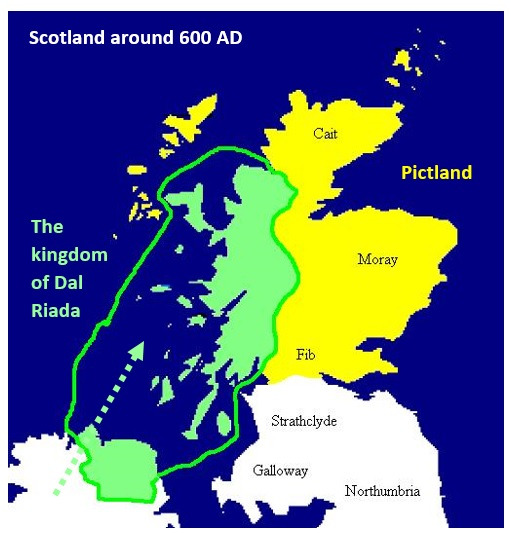
With Christianity came the rapid spread of the Gaelic language into lands outside Gaelic control, especially into the Kingdom of the Picts. Eventually, in the 860s-870s, a certain group called the Vikings appeared. (You may have heard of them.) It was at this time that Scotland unified against a common threat, solidifying the bond between the (likely) Brittonic-speaking Picts and the Gaelic-speaking Scots. Over time, Pictish identity was completely lost (leaving behind difficult-to-decipher standing stones scattered across the countryside), and a unified Kingdom of Alba appeared. (Alba means Scotland - and it's not pronounced how you might think.) Between about 1000 and 1200, Gaelic reached its greatest geographic extent, being spoken across Scotland (the islands at this time were ruled by Vikings, which I'll cover in a later post; however, Gaelic was still spoken, at least in the Western Isles). Some people argue that it was never spoken south of Lothian, but place-name evidence from the Borders calls this into question somewhat (name prefixes such as "bal-" and "kil-" are telltale signs of Gaelic settlements).
Malcolm III (of Macbeth fame), also known as Malcolm Canmore ("ceann mòr", or "big head"), married an Anglo-Saxon princess named Margaret, who had no Gaelic. It was at this time, around 1070, that the first signs of a decline in the language began to appear. Margaret brought English-speaking monks to the Lowlands, in effect drawing a cultural border between Lowlands and Highlands.
By the mid-1300s, Scots, a sister language of English (NOT a dialect!), had become the language of the courts and of the parliament. England, in all its ambition, turned its eyes northward, necessitating an independence struggle (or two, or three...), although this resistance was carried out using Scots (then dubbed "Inglis"), not Gaelic (then "Scottis").

By the time the above image was current (c. 1400), Scottish Gaelic had almost completely split away from Irish, though the written languages were (and to a rough extent, still are) rather mutually intelligible.
Over time, Gaelic became further and further marginalized by Scots. Various government initiatives worked expressly against the language, incentivizing or otherwise encouraging Highlanders to speak the "educated tongue" of the Lowlands. In Scots, Gaelic was called "Erse" (roughly, "Irish"), in a popular effort to "de-Scottify" the language. James VI (and I)'s reign marked a significant downturn in the language's usage. The language was seen as backwards, rebellious, and Catholic (a big no-no in an officially Protestant nation). The language was looked down upon in schools (not to mention broader society) from the 1600s up through the early 1900s, and English became the language of upward mobility for Highlanders and Islanders.
Fuadaichean nan Gàidheal, the Highland Clearances, were a result of the failed Jacobite rebellions throughout the 1700s and the imposition of new systems of land management and ownership. Many Highland families emigrated to the far corners of the British Empire, particularly Canada, the United States, Australia, and New Zealand. Highland culture, for all intents and purposes defunct back home in Scotland, survived in these places into the modern era.
In Canada, Gaelic found much success, especially initially. At one point, Gaelic was the third-most commonly spoken language in Canada, though usage declined markedly between the 1800s and more recent revival efforts in the late 20th century. According to the 2011 Canadian Census, 7,195 people claim "Gaelic languages" as the language they use at home (though this term also includes Irish, Welsh, and Breton, the latter two of which are not Gaelic, but Brythonic). Scottish Gaelic is taught in schools (on an opt-in basis) from primary to university level in Nova Scotia, a province whose name means "New Scotland" in Latin. In Nova Scotia, especially on Cape Breton Island, Highland culture is still very much alive.
What goes on within Gaelic?
Gaelic and its other Celtic cousins are quite unique in the European context, as they place the verb first within sentence structure. It's also quite interesting as its nouns can still inflect for the dual number (at least vestigially), a feature lost in a great many other Indo-European languages (oh, did I mention it's an Indo-European language?). If you've ever seen any written Irish or Scottish Gaelic, you may have noticed they like to put "h" after the first letter of a lot of words. This is a linguistic phenomenon known as mutation, and in this case more specifically as lenition. It changes the pronunciation of the first consonant of the word. This phenomenon has been present in the language since the days of Old Irish (and perhaps even further back into the days of Proto-Celtic).
In terms of spelling and pronunciation, it's astonishingly regular... once you figure out all the rules. There are 11-ish vowel sounds (depending on dialect), and 30 (or so) consonant sounds, a step down from Old Irish's 46 distinct consonants.
To conclude:
If you're committed to learning the language, I would recommend finding fellow learners or even native speakers online, and if you're really, REALLY committed to learning the language, I would doubly recommend making the effort to find a tutor in-person or over Zoom or another video calling service if it's within your means (although this advice goes without saying for learning any language). An institution known as Sabhal Mòr Ostaig, based in the Isle of Skye in the Western Isles of Scotland, must be mentioned in any discussion about learning Gaelic, however. According to their website, they are the "only centre of Higher and Further Education in the world that provides its learning programmes entirely through the medium of Gaelic in an immersed, language-rich environment." (This post is not sponsored.) If you have the time, the money, and the willpower, perhaps give them a look! They work closely with projects such as Tobar an Dualchais and Soillse to preserve, maintain, and revitalize Gaelic language and culture for future generations.
Follow for more linguistics and share this post! If you have any questions, feel free to ask!
#scotland#scottish#gaelic#irish language#scottish gaelic#indo european#linguistics#language#history#culture#celtic#celts#vikings
313 notes
·
View notes
Text
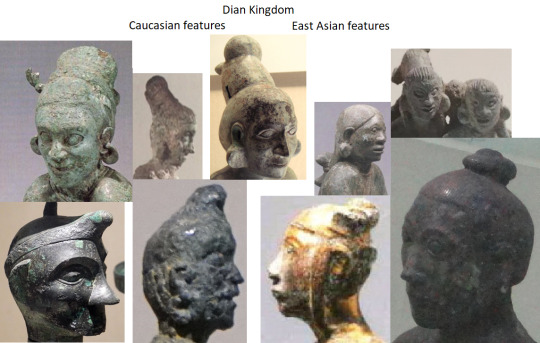

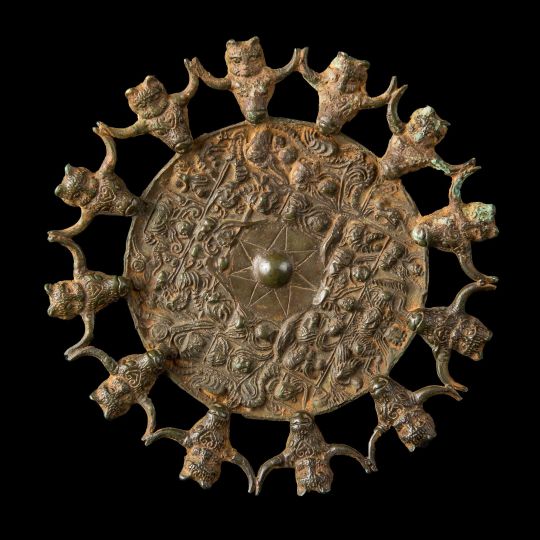
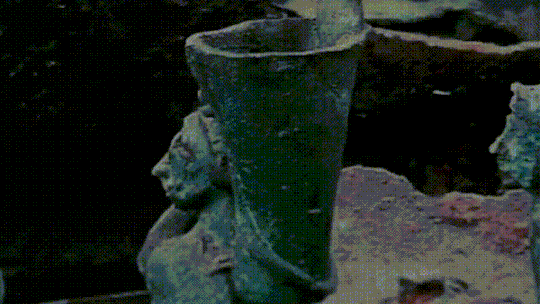

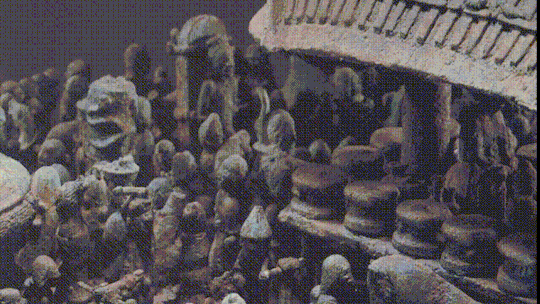

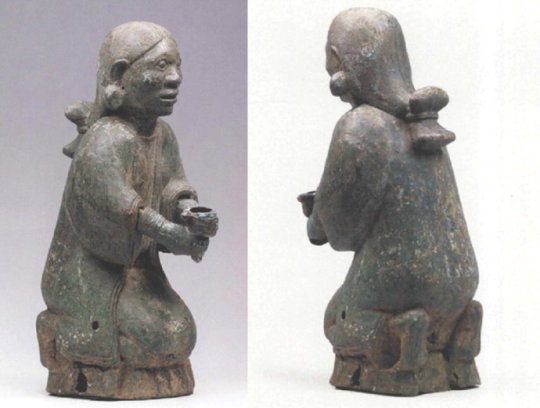

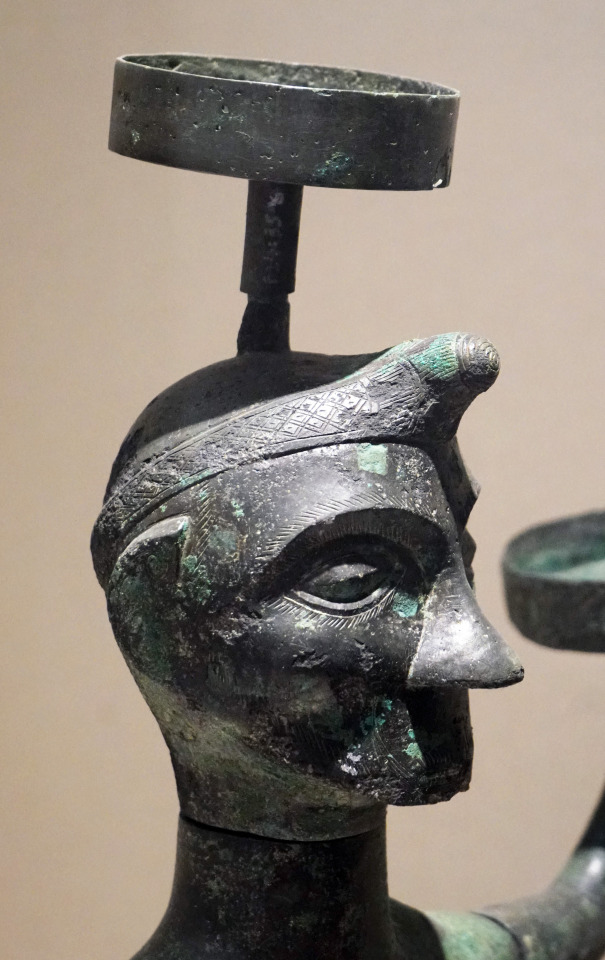

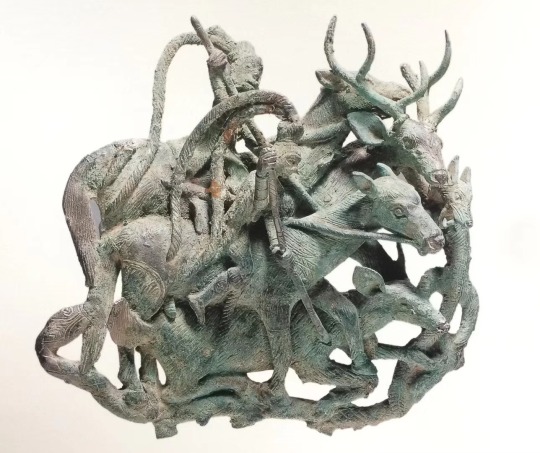





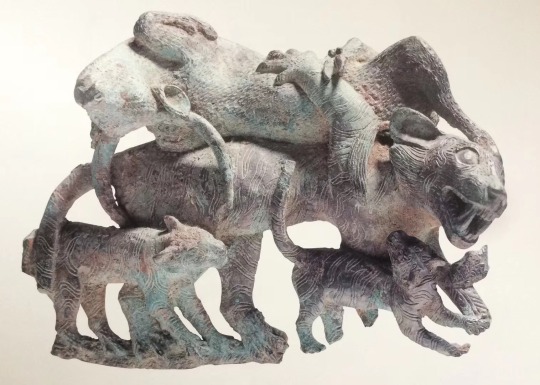

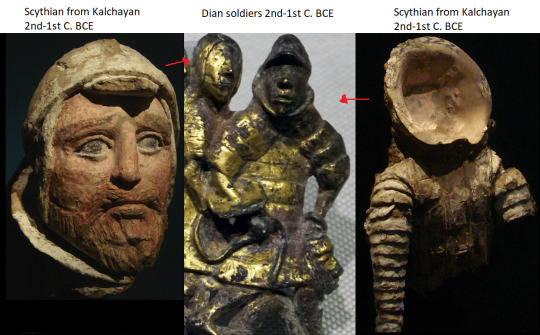
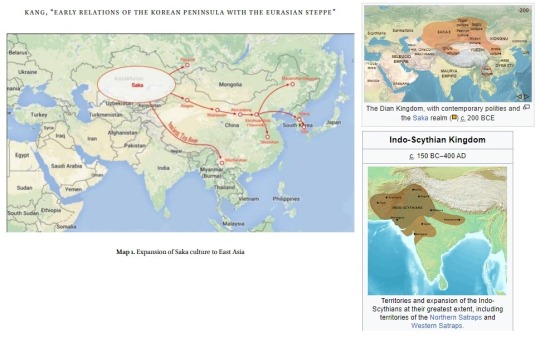


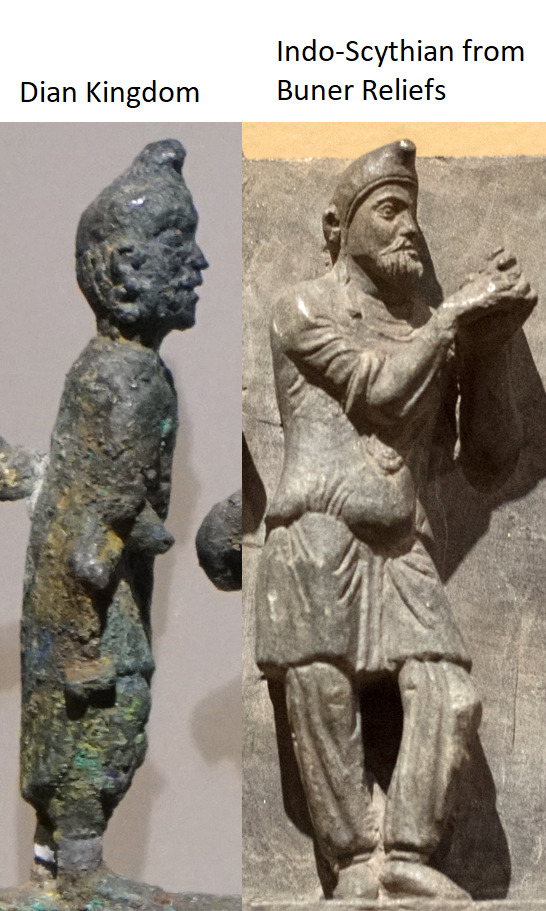


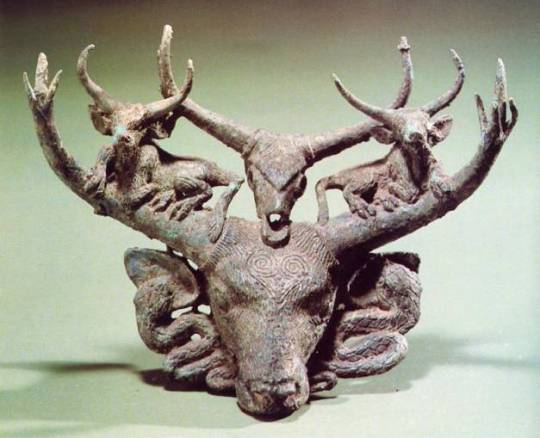
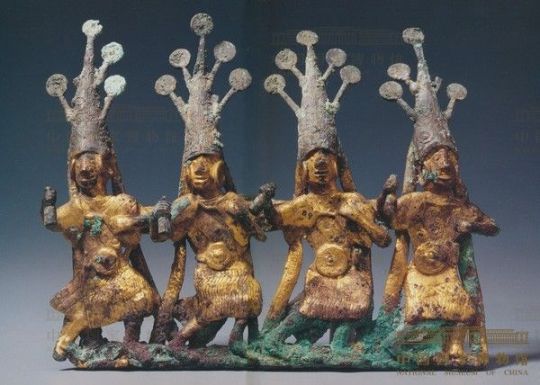

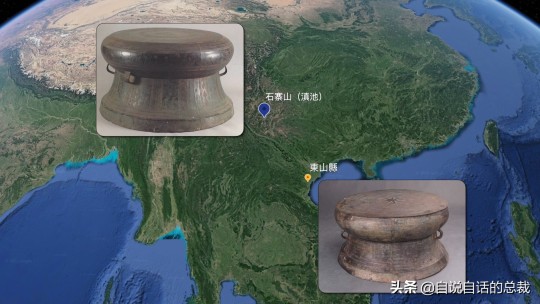
Dian Kingdom 8th-1st C. BCE. Meant to post this one a long time ago but it took me forever to put together. I'm just going to post 30 images here, I got about 100 total on my blog. Link at bottom.
The Dian Kingdom was an advanced civilization in what is modern-day southwest China. It was occupied by the Han Dynasty and incorporated into China after that. From what I've gathered, the people of the Dian Kingdom were probably closely related to the Baiyue people from southern China and northern Vietnam. Wikipedia says they may have spoke a Tibeto-Burman language. I found it interesting that some of these people look Caucasoid though and were wearing clothing similar to Scythians. The image I compared of the Dian man to the Indo-Scythian has a similar facial structure, hat, and even the same type of pants (sorry, I don't have time to tidy up the comparison photos more).
The Dian art theme of the four tigers attacking an ox is found in the same pre-Han period among the Xiongnu at Aluchaideng, and a similar motif appears at Tillya Tepe a couple centuries later. The theme is the same but the style is very different, still it indicates a connection to these places of the world through trade and exposure.
Some of the scenes with soldiers show a variety of different equipment styles and certain subjects have distinct fashion styles (like the people wearing the items that make their ears look huge). I watched a couple documentaries on genetics of the Dian and they were only able to find genetic info for one person, who was identified as similar to the Baiyue people. I'll link those youtube videos in sources below. I assume these people were primarily related to modern day Vietnamese and southern Chinese (or other people nearby) but may have had close interactions with (and even immigrants from) Scythian cultures despite their distance from them, which is interesting.
From the videos: "According to the final count, the amount of bronze ware excavated from Lijia Mountain is almost half the amount of the Shang Dynasty bronze ware excavated in Yinxu, Henan."
youtube
youtube
#ancient history#history#museums#art history#art#sculpture#statue#ancient china#china#vietnam#scythian#artifacts#antiquities#anthropology#archaeology#indo european#Youtube
264 notes
·
View notes
Text
#norse gods#aesir#gods#viking mythology#scandinavian mythology#norse mythology#norse pagan#norse paganism#norse pantheon#norse polytheism#vikings#paganism#old norse#asatru#loki#eddas#prose edda#poetic edda#mythology#indo european#mythology poll#tumblr polls
15 notes
·
View notes
Text
Blackcrowing's Master Reading List

I have created a dropbox with pdfs I have gathered over the years, I have done my best to only allow access to documents which I found openly available through sites like JSTOR, Archive.org, or other educational resources with papers available for download.
That being said I ALSO recommend (I obviously have not read all of these but they are either in my library or I intend to add them)
📚 Celtic/Irish Pagan Books
The Morrighan: Meeting the Great Queens, Morgan Daimler
Raven Goddess: Going Deeper with the Morríghan, Morgan Daimler
Ogam: Weaving Word Wisdom, Erynn Rowan Laurie
Irish Paganism: Reconstructing Irish Polytheism, Morgan Daimler
Celtic Cosmology and the Otherworld: Myths, Orgins, Sovereignty and Liminality, Sharon Paice MacLeod
Celtic Myth and Religion, Sharon Paice MacLeod
A Guide to Ogam Divination, Marissa Hegarty (I'm leaving this on my list because I want to support independent authors. However, if you have already read Weaving Word Wisdom this book is unlikely to further enhance your understanding of ogam in a divination capacity)
The Book of the Great Queen, Morpheus Ravenna
Litany of The Morrígna, Morpheus Ravenna
Celtic Visions, Caitlín Matthews
Harp, Club & Calderon, Edited by Lora O'Brien and Morpheus Ravenna
Celtic Cosmology: Perspectives from Ireland and Scotland, Edited by Jacqueline Borsje and others
Polytheistic Monasticism: Voices from Pagan Cloisters, Edited by Janet Munin
📚 Celtic/Irish Academic Books
Early Medieval Ireland 400-1200, Dáibhí Ó Cróinín
The Sacred Isle, Dáithi Ó hÓgáin
The Ancient Celts, Berry Cunliffe
The Celtic World, Berry Cunliffe
Irish Kingship and Seccession, Bart Jaski
Early Irish Farming, Fergus Kelly
Studies in Irish Mythology, Grigory Bondarnko
Prehistoric Archaeology of Ireland, John Waddell
Archeology and Celtic Myth, John Waddell
Understanding the Celtic Religion: Revisiting the Past, Edited by Katja Ritari and Alexandria Bergholm
A Guide to Ogam, Damian McManus
Cesar's Druids: an Ancient Priesthood, Miranda Aldhouse Green
Animals in Celtic Life and Myth, Miranda Aldhouse Green
The Gods of the Celts, Miranda Green
The Celtic World, Edited by Miranda J Green
Myth and History in Celtic and Scandinavian Tradition, Edited by Emily Lyle
Ancient Irish Tales, Edited by Tom P Cross and Clark Haris Slover
Cattle Lords and Clansmen, Nerys Patterson
Celtic Heritage, Alwyn and Brinley Rees
Ireland's Immortals, Mark Williams
The Origins of the Irish, J. P. Mallory
In Search of the Irish Dreamtime, J. P. Mallory
The Táin, Thomas Kinsella translation
The Sutton Hoo Sceptre and the Roots of Celtic Kingship Theory, Michael J. Enright
Celtic Warfare, Giola Canestrelli
Pagan Celtic Ireland, Barry Raftery
The Year in Ireland, Kevin Danaher
Irish Customs and Beliefs, Kevin Danaher
Cult of the Sacred Center, Proinsais Mac Cana
Mythical Ireland: New Light on the Ancient Past, Anthony Murphy
Early Medieval Ireland AD 400-1100, Aidan O'Sullivan and others
The Festival of Lughnasa, Máire MacNeill
Curse of Ireland, Cecily Gillgan
📚 Indo-European Books (Mostly Academic and linguistic)
Dictionary of Indo-European Concepts and Society, Emily Benveniste
A Dictionary of Selected Synonyms in the Principle Indo-European Languages, Carl Darling Buck
The Horse, the Wheel and Language, David W. Anthony
Comparative Indo-European Linguistics, Robert S.P. Beekes
In Search of the Indo-Europeans, J.P. Mallory
Indo-European Mythology and Religion, Alexander Jacob
Some of these books had low print runs and therefore can be difficult to find and very expensive... SOME of those books can be found online with the help of friends... 🏴☠️
library genesis might be a great place to start... hint hint...
#books#book#resource#blackcrowing#pagan#paganism#irish mythology#celtic#irish paganism#irish polytheism#celtic paganism#celtic polytheism#celtic mythology#indo european#indo european mythology#historical linguistics#paganblr#masterlist#irish reconstructionism#irish reconstructionist#celtic reconstructionist#celtic reconstructionism#masterpost
95 notes
·
View notes
Text

The Dagda
#celtic#pagan#irish#paganism#witch#scottish#celtic mythology#fantasy#art#pagan art#ireland#scotland#european#tradition#indo european#traditional#drawing#sketch#europe#heathen#polytheism#god#the gods
139 notes
·
View notes
Text
Doing research for a conlang
search: indo-european consonant shifts
results: Grimm's law, Grimm's law, nothing but Grimm's law, Germanic languages are the only ones that exist, don't even bother asking about anything else
search: indo-iranian consonant shifts
results: here's a map of Iran, here's ten thousand maps of Iran, and here's a chart of the Persian writing system. How about Indian food near you?
search: proto-indo-european daughter language sound shifts
results: GRIMM'S LAW BABY!!! And here's a map of Eurasia from Wikipedia for your troubles. Fuck you.
I checked; my library district has exactly ZERO books on any of the subjects I'm looking for across 12 branches throughout the entire county. Remember when the internet was the information super highway? I may as well be asking random strangers off the street!
#research#conlang#pie#proto indo european#indo european#linguistics#dead internet#google doesn't work#I haven't used it in months#but duckduckgo isn't any better#no search engines work anymore#I've tried ask and bing and yahoo but they all just show me the same shit as google with different ads based on the parent company#enshittification
19 notes
·
View notes